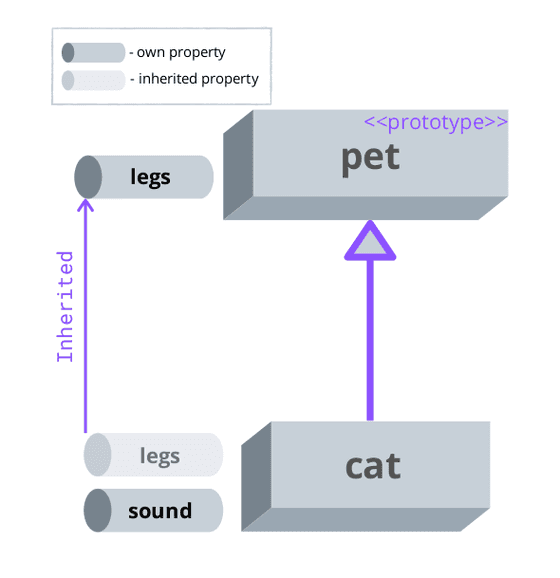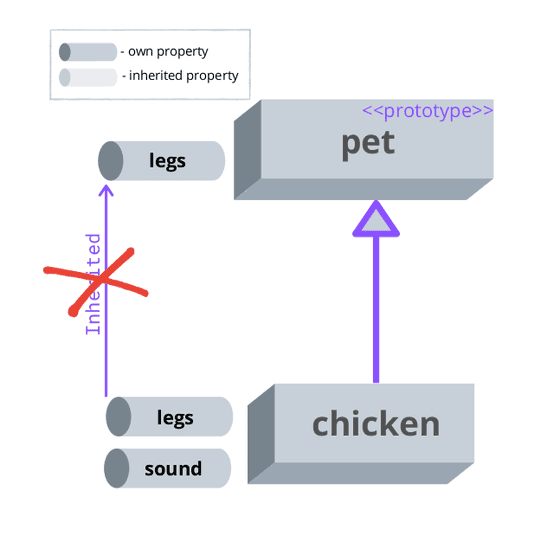Understanding prototypal inheritance is the key to understanding how objects inherit properties in JavaScript.
This concept is also asked often during JavaScript interviews.
In this post, I'll help you understand prototypal inheritance.
1. Introduction
JavaScript has only primitives types, null, undefined, and objects. A big world of objects. In JavaScript, contrary to languages like Java or PHP, there’s no concept of class that serves as a template to create objects.
Let's also recall that an object is a composable structure having properties: key and value pairs. For example, the following object cat contains 2 properties:
const cat = { sound: 'Meow!', legs: 4 };
Since I'd like to reuse legs property in other objects (on dogs, for example), let's extract legs property into a specialized object pet:
const pet = { legs: 4 };const cat = { sound: 'Meow!' };
That looks better.
But how can I connect cat with pet? I can make pet a prototype object for cat!
2. The prototype object
In JavaScript, an object can inherit properties of another object. The object from where the properties are inherited is named prototype.
Following the example, you can make pet a prototype of cat which will then inherit legs property.
When creating an object using the object literal, you can use the special property __proto__ to set the prototype of the created object.
Let's use __proto__ and make pet the prototype of cat:
const pet = { legs: 4 };const cat = { sound: 'Meow!', __proto__: pet };cat.legs; // => 4
cat object now inherits legs from the prototype pet. Now you can use the property accessor cat.legs that evaluates to 4.
sound property, on the other side, is an own property because it's defined directly on the object.

The essence of prototypal inheritance in JavaScript: objects can inherit properties from other objects — the prototypes.
You're probably wondering: why the need for inheritance in the first place?
Inheritance solves the problem of data and logic duplication. By inheriting, objects can share properties and methods.
For example, you could easily reuse legs property to create more pets:
const pet = { legs: 4 };const cat = { sound: 'Meow!', __proto__: pet };const dog = { sound: 'Bark!', __proto__: pet };const pig = { sound: 'Grunt!', __proto__: pet };cat.legs; // => 4dog.legs; // => 4pig.legs; // => 4
cat, dog, and pig all reuse the property legs.
Note: __proto__ is deprecated, but I'm using it for simplicity. In production code Object.create() is recommended.
2.1 Own vs inherited property
If an object has an own property and an inherited property with the same name, then JavaScript always picks the own property.
In the following example chicken object has an own property legs, but also inherits a property with the same name legs:
const pet = { legs: 4 };const chicken = { sound: 'Cluck!', legs: 2, __proto__: pet };chicken.legs; // => 2
chicken.legs evaluates to 2. JavaScript picks the own property legs (which is 2) over the inherited legs (which is 4).

If you delete the own property, then JavaScript picks the inherited one!
const pet = { legs: 4 };const chicken = { sound: 'Cluck!', legs: 2, __proto__: pet };chicken.legs; // => 2delete chicken.legs;chicken.legs; // => 4
3. The implicit prototype
When you create an object, and no prototype is explicitly set, JavaScript assigns an implicit prototype specific to the type of object you've created.
Let's look again at the pet object:
const pet = { legs: 4 };pet.toString(); // => `[object Object]`
pet has just one property legs, however, you can invoke the method pet.toString(). Where did toString() come from?
When you've created the pet object, JavaScript has assigned to it an implicit prototype object. From this implicit prototype pet inherits toString() method:
const pet = { legs: 4 };const petPrototype = Object.getPrototypeOf(pet);pet.toString === petPrototype.toString; // => true
petPrototype is the implement (aka default) prototype of the created object.
Object.getPrototypeOf(object) is an utility function that returns the prototype of an object.
4. The prototype chain
What's interesting about prototypes is that they can be connected in a chain. An object can have a prototype, and that prototype by itself can have another prototype... and so on in chain.
Let's go deeper and create an object tail, making it also a prototype of pet:
const tail = { hasTail: true };const pet = { legs: 4, __proto__: tail };const cat = { sound: 'Meow!', __proto__: pet };cat.hasTail; // => true
cat inherits the property legs from its direct prototype pet. But cat also inherits hasTail from the prototype of its prototype — tail!

When accessing a property myObject.myProp, JavaScript looks for myProp inside the own properties of myObject, then in the prototype of the object, then in the prototype's prototype, and so on until it encounters null as the prototype.
In other words, JavaScript looks for inherited properties in the chain of prototypes.
5. But JavaScript has classes!
You may be confused regarding the statement that JavaScript has only objects. You've probably already used the class keyword in JavaScript!
For example, you can write a class Pet:
class Pet { legs = 4; constructor(sound) { this.sound = sound; }}const cat = new Pet('Moew!');cat.legs; // => 4cat instanceof Pet; // => true
and create a cat when instantiating the class.
The secret is that class syntax in JavaScript is syntactic sugar on top of prototypal inheritance.
The above class-based code snippet is equivalent to the following:
const pet = { };function CreatePet(sound) { return { sound, __proto__: pet, legs: 4 };}CreatePet.prototype = pet;const cat = CreatePet('Moew!');cat.legs; // => 4cat instanceof CreatePet; // => true
CreatePet.prototype = pet assignment is necessary to make cat instanceof CreatePet evaluate to true.
When working with class-es you can completely forget about prototypes.
6. Summary
In JavaScript, objects inherit properties from other objects — the prototypes. That's the idea of prototypal inheritance.
JavaScript looks for inherited properties in the prototype of the object, but also in the prototype of the prototype, and so on in the chain of prototypes.
While prototypal inheritance seems clumsy at first, when understanding it you could enjoy its simplicity and possibilities. Objects inherit properties from objects — what could be simpler?
Have questions about prototypal inheritance? Ask in a comment below!


